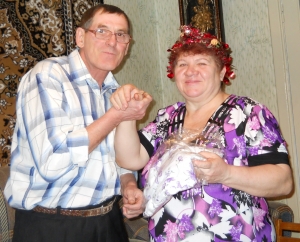There is a lot of information on the Internet about Alexander’s achievements, but not much is known about how he got where he is. The “Bear” armed response company soldier tells us about his road to armwrestling.
Alexander, how did you get into armwrestling?
It was January 2003. I was a student and we used to wrestle on school benches, two of my friends wound up in the finals. I weighed about 67 kg, Ilya Troshkov, nicknamed “Tiny”, weighed some 114 kg. Each one of us won in one hand, lost in the other. One the 23rd February my coach, Alexander Pozdnjakov, posted an information about city championships. My friends got me to participate. I tried to resist, until Ilya himself leaned on me to enter. He was the first to notice the technique: “Sanya, look, they move their arm closer to the grip…”. Here’s how it all began. I fought in the Solikamsk championships with no preparation whatsoever. I’ve beaten the “seventies” champion of the Permsk region flawlessly. In OPEN I took first place, right hand. I’ve lost in left, because I had no technique. The other guy pulled me so hard that both my feet left the ground for a moment.
An actor always remembers his first role. What is your most vivid memory?
My first golden medal – European Championships, Bulgaria 2009. It was there that I realized I need to fight not only my opponent, but also try to feel the referee, “fight” him a little.
Who was your first coach?
I’m my own first and most constant coach. Thanks to my other first coach and manager, Alexander Pozdnyakov, I’ve gained experience, visited many tournaments, including the New York Intrepid. And we all know the USA way of armwrestling, everybody knows John Brzenk.
The first coach builds the foundations of their student’s style. How did you learn to fight, if you had no coach?
Good genetics. My parents were an important factor – my mom was an ice skater and a skier, my father was a hockey player. I’ve studied many videos of such fighters as Nikolai Grigoriev, Roman Tsindeliani, Aleksander Bulenkov, Siergiej Blohin. Through each new injury I learned something new. First there was the “sideways over the top”, then a few “over the top” variations. Now I need no more than 29 seconds from the referee’s setting to “read” my opponent’s arm. It’s an x-ray – I know where he’ll move, so I put up instant resistance. My motto is “Don’t lose faith, life hits hard. It doesn’t matter how you hit, it matters how you resist and if you can get up and fight again!”. I was greatly motivated by a couple of sports movies. “Shadowboxing” is my favorite.
Where do you work? Does work affect tour training?
I’m a soldier in the “Bear” armed response unit. My work helps me develop stamina. I spar a lot in a gi, but wrestling is not akin to armwrestling. My fastenings are accustomed to pulling towards me, here they have to work in the opposite direction. I’d like to take this occasion to thank my coaches from the unit – Vladimir Kazantsevov, Niftalyi Rustamovov and Mikhail Smirnovov, for including me in the team.
What’s missing in armwrestling promotion, in your opinion?
The show aspect! Aside from Igor Maurenko, nobody else tries to put on a show. New ideas are needed. Many promoters focus only on the armwrestlers, but common people don’t know what “Rady-Go!” means, what it means to win in a few seconds. For a fight to be attractive, opponents need to be chosen so as to be nearly equal. This way the fights will be longer, more attractive for the audience. Maybe then armwrestling will become more popular, be an Olympic sport!
What makes your training unique?
I’m expecting a tutorial video of my trainings on a machine designed by me. Soon the project will be ready, in cooperation with Igor Mazurenko. I’ve been working on this for 10 years, soon you’ll all be able to see the effects.



Artur Grigorian

